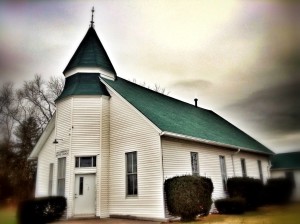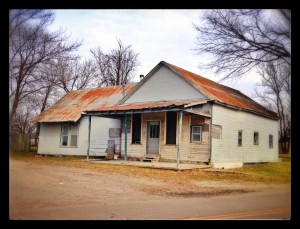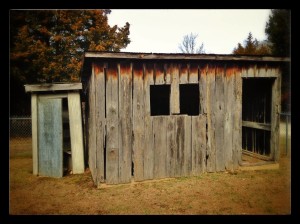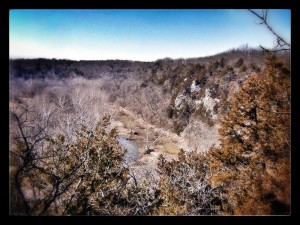It is not lost on me that Memorial Day is all about honoring our veterans, and especially those who lost their lives while serving our country. But for many folks during the time I was growing up, Memorial Day …. or “Decoration Day”…. as some of the old-folks called it, was for remembering and honoring ALL those family members, friends, and neighbors who had gone beyond the veil. What follows does not talk much about our veterans. Rather, it is a collection of some of my own memories of Decoration Days gone by. – J
Fried chicken at a picnic table beside the highway on the last weekend in May, same table as last year and the year before. Cold Cucumber salad with onion and vinegar. Peeled and sliced tomatoes, slaw, yeast rolls, homemade of course. A plate with sliced country ham and biscuits. Another with fried chicken. Decoration Days are always just this way.
Dad’s sister, my aunt, fussing over getting each dish set out on the table as mom spreads the well-worn red and white checked tablecloth, making sure things don’t blow away in the wind. The weight of the syrupy sweet iced tea poured into the tall, blue and pink and green colored Tupperware cups helps hold that cloth down too.
My dad and his dad, along with my uncle, all staying out of the way, standing off to the side, talking the way grown-ups do. So much on and on and on about nothing in particular. Conversation that didn’t need a reason beyond the fact that they were all together. Conversation that didn’t accomplish much as far as I could tell.
My cousin, one year older, and always one step ahead. One step ahead in everything. My cousin, who I looked up to so much. My cousin who invented elaborate games, with complex rules. Whatever he tells me, I believe. If he had told me the picnic area on the side of the road where we were now eating had once been a major stop on the Pony Express, and there had been a famous Indian massacre there in the 1872 where those young riders had been slaughtered, I’d have believed him unconditionally. Unconditionally, and together we would have cursed the damn Indians. But not within earshot of his mom or mine. Not within their earshot, so as not to draw their wrath for using language as salty as the country ham from my grandfather’s smokehouse. Country ham that was just then being served up on the biscuits his mom had made from scratch that morning.
They were Baptists, my Aunt’s family. We were Methodists. Neither group condoned that kind of language. Especially the Baptists. Not even when it was about condemning heathen Indians scalping innocent white boys delivering the mail on horseback.
One thing was certain. My cousin and I would find time to talk about lizards. We always talked about lizards on Decoration Day. He knew all there was to know about lizards. What they ate (flies and wilted lettuce …. though I would come to doubt the lettuce part), where they lived (cool dry places, but where they could easily get plenty of sun whenever they wanted).
He knew how to tell by their color and skin patterns which lizards it was okay to touch, and which ones would secrete a sticky goo onto your skin that might leave painful boils or red welts.
I’d never had a lizard-produced boil or red welt, but my cousin told me it might happen and that he’d read it in a book, and I believed him unconditionally.
After lunch, trash and chicken bones and scraps went in the barrel. Then, all of us back in the cars and on down the highway until we pull off onto a blacktop. Motoring past farms and fields, with anticipation growing. Many houses we pass elicit comments from the grown-ups about who lived there and what their latest ailment was, or who their kids married or even sometimes what they had recently died from.
“There’s old Eli Carter’s house. Is he still alive?”
“Yep, he and the missus still live there. Probably just sitting in there on the couch with the TV on.”
“He’s gotta be eighty-something”
“We should stop on the way back and say hello”.
“Maybe we’ll stop and say hello. But we won’t stay long.”
That was always the plan. Stop and say hello, but don’t stay long.
I think to myself that if the grown-ups DO decide to stop, I just hope it’s not close enough to meal time that they’ll feel too awkward to refuse the inevitable invitation to “dinner”. If there’s one thing I hate, it’s when we get stuck unable to refuse an invitation to dinner in a stranger’s house.
I’m quite sure these old people eat icky food, maybe even pickled okra or creamed corn that they grew in their own gardens or God forbid Jello with STUFF in it. Some of these folks make Jello and put carrots in it. Who DOES that? I mean seriously. Vegetables in Jello?
I’m pretty sure that old people with liver spots have kitchens that aren’t very clean at all, because the old lady’s eyesight is failing and anyway she shops in dirty unfamiliar stores and keeps stuff like all of that on hand just for torturing the kids of barely-known old friends and acquaintances who might perchance stop by with the intention to say hello but not stay. People who don’t really intend to stay, but who then decide to stay anyway. Because they’ve been asked to stay, and they’re afraid that to leave now would be rude.
What’s worse, having stopped at plenty of these old folks places through the years, I also know that their houses will smell funny and their black and white TV’s will only get snowy reception on weird programs, and they won’t have Pepsi to offer us so we’ll have to either drink cloudy, possibly dangerous tea or water from a well. Water that tastes very peculiar. Not like my good “city water”.
I also know that my mom and dad love some of these people like family, but I surely don’t know why.
Then, after several miles of blacktop, just as the road forks and changes from asphalt to gravel, there are five or six buildings all together, the most we’ve seen in one place in miles. Dad says on cue, but yet almost as a casual aside, just as he says every year: “This is the town where I was born”. My Pa Pa says, “Yep”, and points and says, “Right over there”, but I can’t tell exactly where he’s pointed. Me, snapping to attention, looking around, and wondering why dad used the word “town” when clearly there was no town there and it didn’t look like there ever had been a town there.
There was one building that might have been a store at one time, judging by the wide porch and windows and an old gas sign even though there aren’t any pumps anymore and probably haven’t been any pumps in decades. Still, he says it’s a town, so I look at the house that I suppose he was born in though I don’t know why I think that’s the exact one, since Pa Pa had only pointed in the general direction. I marvel that babies were born in houses like that and not in big shiny hospitals with bright lights and mysterious rooms that smell all hospitally. My aunt, two years older than dad, never says anything about where she was born, and I wonder why.
After passing through this place, the land gets a bit more rolling, and the hills a bit higher and closer together. Soon we turn left onto a road that is smaller yet, and far more bumpy.
After a short while, we make a sharp turn to the right past a very smelly hog lot with ramshackle barn. A few hundred yards more, with woods closing in on both sides of the road we make a sharp turn left, and then within a quarter mile or so we pull up to the clearing with the cemetery. The cemetery with the old fence and the newly painted gate. 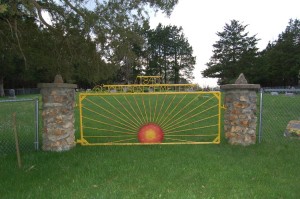 The gate that has a wrought iron setting sun.
The gate that has a wrought iron setting sun.
Only back then I never thought of it as a setting sun, but a rising one, and it gave me some comfort that this might somehow be not such an unhappy or dreary place for the souls of those who were buried there.
I’m not sure exactly when in my mind the shift in perception happened that changed the gate from having rising sun to a setting one, but I’d like to know. I’d like to know, because I think maybe that shift is important in some way that I almost understand but not quite. Like one of those optical illusions that when you first look at it is a young woman in a fancy hat, but the longer you look at, you suddenly see that it’s ALSO an old lady in a shawl. Or maybe you saw the old woman first, and had to concentrate and squint your eyes to see the young one But once seen, can never be unseen.
Maybe that point where the gate with the rising sun became also that gate with a setting sun is the precise moment at which I no longer was the innocent kid who dreamed of being an astronaut, and suddenly became the adolescent who realized he really was going to grow up someday into a complicated world and that life has a lot of setting suns.
Or maybe I’m just over-thinking it.
In any case, pulling up to that cemetery each year is something of a magical moment in my memory, regardless of which way I saw the gate.
We get out, and stand there for a minute beside our cars, suddenly stunned by the silence after the noisy rumbling of the car wheels on the gravel road. Hard to say if the silence is more reverent or eerie. Probably a little of both. Either way, the silence is a sharp contrast, and it’s probably the reason nobody yet has ventured in through the gate and into the area with all the headstones.
Perhaps even the grown-ups feel, as I do, that maybe just maybe we’re intruders here and the slumbering souls beyond the gate could have gotten along just as well without us. I can hear birds chirping.
Nobody is saying much until one of the adults will make a remark about how nice they’ve got the place looking, grass cut and weeds trimmed. We venture forward, and dad swings that Sunrise/Sunset gate open. All of us walking through as one, we maintain our relative silence. Whatever comments are made are made in hushed tones.
“There’s George Anderson over there.” Somebody nods to a stone with a small flag planted by it.
I realize anew, as I do each year, that there were several of these similarly flag-marked stones scattered around the grounds.
“He passed in France in the war, didn’t he?”
“Yes. His mama never got over it. He was her only boy. She died of a broken heart shortly after the war”
And, “There’s Miss Botts” “Didn’t she die of the consumption?”
“Mmm hmmm, poor thing … so young.”
There were a few newer stones, but only a very few. This was an old cemetery, 1840.
There were civil war dead buried there, and folks whose names time had forgotten and the elements had erased from view on their headstones. I’d sometimes stand for a while in front of a worn down stone with absolutely no identifiable markings, just a small, mostly irregularly-shaped marker worn by years of rains and ice and snow and elements, and wonder if maybe there was somebody still living that knew who was buried there, had fond remembrances of them, and would come at a different hour to pay their respects. And if so, why had they let the gravestone deteriorate so badly? Maybe they simply couldn’t afford a new marker.
But then I’d think that no, probably nobody knows or remembers who is there, and whatever the person beneath my feet did in life is now gone forever. I remember thinking this, and feeling sad.
Still, I liked how the adults talked about those people buried there as if they weren’t necessarily dead, but maybe had just stepped out of our field of view for a bit. As if they might be coming back at any minute with stories to tell and their families would laugh and clap them on the shoulder and give them a hug all would be well. I liked the idea that even though untold years had passed, these people buried here had been friends and neighbors and had breathed deep of the air in these hills, and felt the warmth of the sun and heard the birds the way I did.
We made our way through the stones, and our destination was clear. A couple of small headstones in pretty much the center of the cemetery. Not the big flashy kind that stand up tall, and include a bit of scripture or some bright encouragement about rejoicing in the land beyond the skies. No, these were the kind that were low to the ground, and had names and dates.
Those names were OUR names. But the people were people I’d never known.
Minnie Teel Shouse, August 25, 1892 – October 1, 1921. My grandmother.
I was good enough at arithmetic to see that she was just 29 years old when she died. My dad, who was born in 1918 was just three when his mom died, and realizing that, each year all over again always made me a little sad. I wondered if he remembered her at all. I looked at my mom and told myself I’d never ever in a million years forget her pretty face and her smile.
Next to my grandmother’s stone was an identical one that said Ora Elwood Shouse, March 15, 1921 – April 12, 1932. My dad and my aunt’s little brother.
It wasn’t until many, many years later that I realized the second date was actually 1932. Somehow in my memory it was 1923, a bit of dyslexic confusion. I had assumed for years that dad’s little brother had died just after his second birthday. But I was wrong, and it was for that reason that I never once asked my dad what his little brother was like.
Dad wasn’t five when Elwood died. Instead, he would have been fourteen when they lost him. I wish I’d known that back then on those Decoration Days, and had taken time to ask dad about Elwood.
In Missouri, the state has now filed electronic copies of death certificates online, and Elwood’s certificate confirms the 1932 date, and lists the cause of death as “Aortic Insufficiency”. A leaky heart valve. Something that today would be easily treated relatively easily either medically or with routine surgery. But in 1932, it killed the 11 year-old boy who might have grown to become my uncle. Or maybe he would have fought and possibly died in WWII.
I wonder what thoughts went through my Pa-Pa’s mind as he stood there and looked down on the graves of his young wife and son. He had never remarried, but had raised two kids on his own, supporting them with his trade as a blacksmith and by doing some small amount of subsistence farming.
It never occurred to me then that in a few short years, there would be a third identical stone to join those other two. It would have Pa Pa’s name on it and his birth date of November 28, 1888 and a second date after the dash. I never gave a thought to when that second date might come. I wonder if he did?
I didn’t know then, and had no reason to even suspect, that within the next ten years or so, I would have literally dozens of unofficial “Decoration Days” where I drove those same roads by myself. Days when I would drive south from where I lived in Columbia in my college years, and would stand in silence at the stone of the man I knew. The man whose body had been placed there beneath the ground next to his young bride and their son, almost fifty years after she had died.
Back on that particular day though, my mom and my aunt are bending down pulling what few weeds there are around the graves and the two markers, and they’re placing the flowers brought fresh from my aunt’s garden ….. this is the “Decoration” part of Decoration Day. Were they trying to make it cheery for the dead? Or to brighten it all for the few moments we would be there that day? The men start to drift around the cemetery looking at the other headstones scattered there, and still occasionally making a random comment now and then about the folks buried just under their feet.
The stones are not laid out in orderly rows like the other cemetery we’d visit later, where my mom’s parents and my dad’s grandfather and grandmother were buried. Instead, they seemed to me to be laid out with no sort of rhyme or reason for the placement.
Whether the adults were looking at the stones in the front that were somewhat newer and out in the open under the springtime sunshine, or the stones in the back under the tall cedars, they’d still occasionally stop for a second in silence. Those in the back were mostly far older and more worn down making them hard or even impossible to read.
There was one that I recall, and though I don’t know the dates or the name, I wonder if maybe she was somebody else’s young wife or maybe a daughter. The verse on it was faded, but you could just make it out.
It said “The sun shone brighter because she was here.”
I remember reading that verse every year. I was always surprised that it made me smile and want to cry all at the same time. I wonder if Pa-Pa felt that way about his young wife Minnie. I hoped so then, and I still hope so now.
Before long my cousin and I would tire of wandering among the gravestones. After all, even including our grandmother Minnie, and young uncle Elwood, there was nobody buried there we had actually known when they were alive. So we turned our attention to the grave-digger’s shed.
I suspect the man, whoever he was, would have preferred to be known as the caretaker of the cemetery, but the shed WAS full of shovels and picks, after all. So to us, he was the gravedigger.
The shed was a very rustic little structure made out of VERY weather-worn lumber, with a single door, a couple of windows, and a dirt floor. Immediately adjacent to the shed was an outhouse. From the smells wafting about as you got near the outhouse, and the presence of a new supply of Sears Roebuck catalogs, and the copious amount of flies buzzing about, it was indeed occasionally used.
Our attention however was on the shed. Somewhere, either on the inside walls of the shed or lounging around on the outside sunning themselves, we could be certain of finding a number of lizards. That shed was lizard-central. A veritable lizard Mecca in the heart of Mid-Missouri.
With enough stealth and no sudden movements, and by slowly moving a hand up low behind them, my cousin and I would capture a lizard or two apiece. Year-in and year-out, the last weekend in May was when I looked forward to replenishing my stock of lizards. Of course, I’d bring the lizard (or lizards) home, often over mom’s protests, and they’d invariably escape or die. Escape was NOT okay with mom.
She didn’t seem to care if they died. How somebody so sweet in every other aspect of her life could be so callous when it came to lizards is a mystery that I never understood. Sometimes their tails would fall off from my over-exuberance in playing with them in toy cars or trains. My cousin had told me that if that happened, not to worry, because the tails would grow back. He told me, and I of course believed him. But I never had a lizard long enough to actually have one grow a tail, so I never really knew how long that took. Maybe I’ll find out next year.
Maybe I’ll find out, come Decoration Day.
If I could only ride along one more time on one of those trips. To eat the fried chicken and country ham and cucumber salad at the table beside the highway, to marvel at the tales my cousin made up to tell me, see the town where dad was born and be able to ask him all the questions I wish I could ask him. To see my PaPa’s face as he gazed on the graves of his beloved bride and young son. To give him a moment to himself, but then to put my arm around him and ask him to tell me about her, and about him. To see the old stones in that old graveyard and hear the stories about the people buried there from the ones who actually knew some of them.
To catch myself a lizard. And maybe even to let it go (with or without a tail) in some old person’s home. In a strange-smelling house after we stop to say hello, without planning to stay. I might even eat the orange Jello with shaved carrots.
On Decoration Day.
Yes. I’d love me some of that.
John
Postscript 1/4/2015 –
“Time stands still best in moments that look suspiciously like ordinary life.”
I took a short trip back to Missouri from my home in Tennessee on New Year’s weekend. My son Brendan, who is now 19 accompanied me. On Friday, Jan 2, it occurred to me while in Missouri that it would be good to drive those roads with him, to visit the cemetery one more time, and to have the chance to talk about some long-gone members of his family and tell him what I recollect about the places and people from the days I wrote about in this piece. 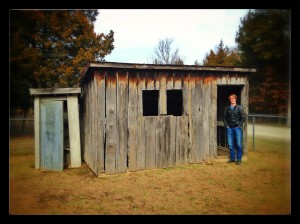
I also took some pictures, which I’ve inserted here and into the story above.
One of the things we did many times on those Decoration Day trips years ago was to visit a nearby area known as “The Devil’s Backbone”. The main feature of the Backbone was a narrow ridge of limestone running straight down into a broad valley with a winding creek. Years and years before my memory, there had been a road down that ridge and into the valley. The remnants of the road were still there back when I was a kid, but it was not drivable, meaning the only access down into the valley was on foot.
When I was in college, that area became a refuge for me. There were countless times when in search of solitude, or some place to find my balance, my center, I would travel those roads out to the cemetery, and then to the Backbone.
Parking at the top, sometimes I’d simply sit on a bluff up there overlooking the valley below and just enjoy the sunshine and relative isolation from the hubbub of daily life back on campus. Other times I’d hike down the ridge to walk the valley, wade the creek. Often down there, would find a sunny spot on a rock to sit and make sense of the world. In those days, the only sound of civilization was likely to be a jet overhead, or possibly the far-off sound of a farmer’s tractor. But more often, the only sounds at all were the wind, the rippling water in the shallows, and the birds.
It was, and remains, a very special place in my memory.
The old bridge at the bottom of the Backbone ridge was not, in my memory, ever passable by car. 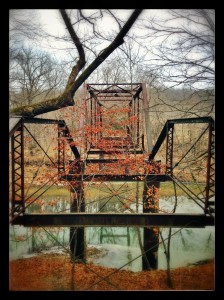 Back then, there were a few rotten boards present, but it had been many years since they had even been suitable for crossing the bridge on foot. I do remember being brave enough to walk part way out on the bridge, barely over the water, but that was as far as one could go.
Back then, there were a few rotten boards present, but it had been many years since they had even been suitable for crossing the bridge on foot. I do remember being brave enough to walk part way out on the bridge, barely over the water, but that was as far as one could go.
In this trip with my son this past weekend, the rusty frame of the old bridge was still there, but not a single sign of anything resembling a board.
Hiking down the ridge to the bottom this weekend with him, the sensory experience it triggered in my mind and in my heart was identical to what I remember from those trips back then. This is, for me, a reverential place. A place of wonder and silence and retreat.
It was and is a kind of unexpected wild-place, the kind that has become increasingly difficult to find these days. I told my Brendan much about those trips I’d make down into that valley, and I encouraged him to try tofind a place for himself that fills that role in his life. I think that is important. His school up on the Cumberland Plateau in Tennessee should be close enough to a lot of places that might work perfectly.
This was a magical trip to a very special place.
In years to come, there will certainly be many things I will forget.
This trip with Brendan is not one of them.
John

